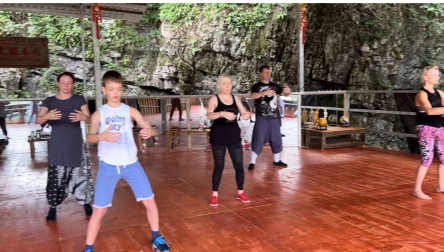Tai chi Meditation
WHY MEDITATE…
LEARN SOME OF THE BENEFITS OF TAI CHI MEDITATION..
Tai chi Meditation can help to change or improve your quality of life. The Meditation Classes will teach you (mindfulness). Tai chi Meditation is a way to calm the mind and body. It helps us to become aware,to be able to live in the present moment. Do you often return from work stressed out and unable to relax.
Chen Style Tai chi Standing Meditation and Sitting Meditation is now made Plain Simple for you to learn in one day. After that, You can take as little as 10 minutes a day anywhere, any time, to enjoy this proven ancient technique to relieve stress and stay healthy.
TAI CHI’S STANDING MEDITATION POSTURES…
- SINGLE WHIP (DAN BIAN)…
- LAZILY TYING ONE’S COAT (LAN ZA YI)…
- DIAGONAL POSTURE (XIE XING)…
- PRIMORDIAL POSTURE (HUN YUAN ZHUANG)…
SINGLE WHIP…
DAN BIAN …
With your head held naturally erect ,let the top of your head rise up naturally as if it were suspended (xu ling ding jin). Stand upright in a balanced posture (li shen zhong zheng) with a level gaze and your teeth lightly touching. Your two elbows sink downward and your shoulders are relaxed. Your two hands draw or guide your internal energy (jin).
Relaxing your hips and bending your knees, you must keep your groin rounded. Your left leg is weighted (shi) and your right leg is relatively without weight (xu). The tip of your left foot toes out and the tip of your right foot toes inward. Concentrating your consciousness, relax your entire body and let your internal energy(qi) sink to your lower abdomen (dantian) then descend down to the acupuncture point under the front part of your foot (yongquan).
LAZILY TYING ONE’S COAT …
LAN ZHA YI…
With your head held naturally erect, let the top of your head draw upward as if it were being lightly drawn upward by a string attached to your crown (ding jin ling qi). Standing upright in a balanced posture, extend your right hand out to your right side and hold your waist with your left hand.
Relax your shoulders and sink your elbows. Your left arm is rounded in shape with no sharp angle at the elbow. Relaxing your hips (kua) and bending your knees, you must keep your groin rounded open and not pinched together. Your right leg is weighted and your left leg is relatively without weight. The tip of your right foot toes in. 70% of your weight is on your right leg and 30% of your weight is on your left leg.
DIAGONAL POSTURE …
XIE XING…
Take a diagonal step posture with your weight on your left leg. The tip of your left foot toes out and the tip of your right foot toes in. Relaxing your hips and bending your knees, the energy of your groin (dang jin) twines inward (nei kou) on itself.
Stand upright and balanced. With your body rotated slightly to the left, your two arms are extended outward, perpendicular to a line intersecting your two feet. Your two feet and two hands are each oriented to one the four corners of square. Your eyes look straight forward.
PRIMORDIAL POSTURE…
HUN YUAN ZHUANG…
Concentrating your consciousness on a single point, your thoughts settle down and become tranquil. Standing naturally upright, your entire body relaxes. Your two arms form a circle, with your two palms facing inward toward your body and the fingers of each hand pointing tip to tip with the fingers of the opposite hand. Sink your elbows and relax your shoulders; your two feet about a half meter apart. Bending your knees and relaxing your hips (kua), squat down and keep your groin rounded by rotating your knees slightly inward. Lightly grip the ground with the ball, ridge and heel of each foot –keeping the center of your foot (yongquan) “empty” of weight.
These few standing meditation postures (zhong ding shen fa) above are also called standing post (zhuang gong) training. After every time you practice some basic exercises (such as chan si jing) you should stand for 5-10 minutes. At first stand in only one, then two, then more postures; starting with a short amount of time and gradually increasing to a longer amount of time; starting from a higher stance and gradually progressing to a lower stance –gradually increasing your athletic capability. When you practice standing meditation postures, there aren’t any complicated movements so it is easy to concentrate your consciousness, making it possible for you to master standing upright in a balanced posture, relaxing your entire body, releasing the tension in you upper torso (xin qi xia jiang) and allowing your internal energy (qi) to sink to your lower abdomen(dantian).






